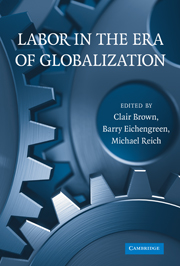Book contents
- Frontmatter
- Contents
- Tables and Figures
- List of Authors and Editors
- Introduction: Labor in the Era of Globalization
- PART ONE POLITICAL ECONOMY AND LABOR MARKET INSTITUTIONS
- PART TWO INSTITUTIONS AND FIRM AND WORKER BEHAVIOR
- PART THREE CONTEMPORARY LABOR–MANAGEMENT RELATIONS
- PART FOUR PUBLIC POLICY AND U.S. LABOR-MARKET STRUCTURE
- 11 Minimum Wages in the United States: Politics, Economics, and Econometrics
- 12 The Causes and Labor-Market Consequences of the Steep Increase in U.S. Incarceration Rates
- 13 Local Labor-Market Adaptation to Increased Immigration
- Index
- References
12 - The Causes and Labor-Market Consequences of the Steep Increase in U.S. Incarceration Rates
Published online by Cambridge University Press: 05 June 2012
- Frontmatter
- Contents
- Tables and Figures
- List of Authors and Editors
- Introduction: Labor in the Era of Globalization
- PART ONE POLITICAL ECONOMY AND LABOR MARKET INSTITUTIONS
- PART TWO INSTITUTIONS AND FIRM AND WORKER BEHAVIOR
- PART THREE CONTEMPORARY LABOR–MANAGEMENT RELATIONS
- PART FOUR PUBLIC POLICY AND U.S. LABOR-MARKET STRUCTURE
- 11 Minimum Wages in the United States: Politics, Economics, and Econometrics
- 12 The Causes and Labor-Market Consequences of the Steep Increase in U.S. Incarceration Rates
- 13 Local Labor-Market Adaptation to Increased Immigration
- Index
- References
Summary
INTRODUCTION
The United States currently incarcerates its residents at a rate that is greater than every other country in the world. Aggregating the state and federal prison populations as well as inmates in local jails, there were 737 inmates per 100,000 U.S. residents in 2005 (International Centre for Prison Studies 2007). This compares with a world average of 166 per 100,000 and an average among European Community member states of 135. Of the approximately 2.1 million U.S. residents incarcerated in 2005, roughly 65 percent were inmates in state and federal prisons and the remaining 35 percent resided in local jails.
Moreover, current U.S. incarceration rates are unusually high relative to historical figures for the United States itself. For the fifty-year period spanning the 1920s through the mid-1970s, the number of state and federal prisoners per 100,000 varied within a 10- to 20-unit band around a rate of approximately 110. Beginning in the mid-1970s, however, state prison populations grew at an unprecedented rate, nearly quadrupling between the mid-1970s and the present. Concurrently, the rate of incarceration in local jails more than tripled.
These trends in incarceration rates are a likely source of increasing socioeconomic inequality along a number of dimensions. First, there is growing evidence that prior incarceration and conviction adversely affect the employment prospects of former inmates. Second, recent research has linked the increase in incarceration to a number of secondary, negative social externalities affecting the members of the communities that disproportionately comprise the sources of our nation's prison inmates.
- Type
- Chapter
- Information
- Labor in the Era of Globalization , pp. 375 - 413Publisher: Cambridge University PressPrint publication year: 2009
References
- 1
- Cited by



